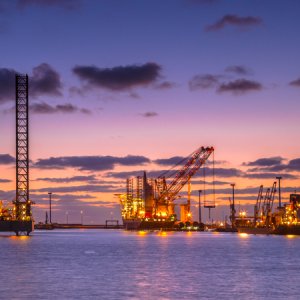AMEXHI Helps Steer Mexico's Upstream Through Rough Waters

STORY INLINE POST
Q: What impact is AMEXHI expecting from COVID-19 on the development of contracted areas in Mexico?
A: It is hard to assess the effect of the crisis while we are still in the middle of it and there are many questions that remain unanswered. The government has announced that Mexico has entered Phase 3, so at the moment, it is difficult to predict the extent of the impact on industry operations. What is clear is that there will be changes to previous forecasts. Whenever forecasts are made, assumptions are also made and one of the main assumptions in oil and gas is the price of oil. Previous forecasts were made based on assumptions of a specific price for oil but this price has changed dramatically. As the dust settles, the industry will be able to reassess its position.
Q: What actions is AMEXHI taking to assure the best outcome for operators?
A: AMEXHI implements many measures to support operators. The most important is the help we provide in preserving human life – this is paramount for operators and ourselves. On the HSE side, we have hosted forums where different experts shared best practices for crew changes at onshore and offshore fields, or best practices for medivacs from offshore rigs, as well as other general safety procedures. We have also strengthened links with government health institutions, including Cruz Roja, throughout Mexico and helped set up links to private companies.
We placed a great effort to focus on supporting suppliers. This is because the latest developments from the government do not make it clear whether suppliers, in their various forms, are considered within the ambit of essential activities. We have been working with the Ministry of Economy, which oversees these processes, to ensure that the supply chain is included within this essential activity group. A good example of the need for this is cement producers, which were not categorized as essential industries at the beginning of the outbreak. But cement is a critical component when drilling wells and without cement supply, drilling cannot progress. Thankfully, with the help of the Ministry of Economy and other associations, this initial problem was rectified. Maintaining communication with different stakeholders is key to the continued health of the oil industry.
Q: How can Mexico’s supply chain overcome the difficulties presented by the crisis?
A: This crisis is no different than previous crises. AMEXHI members ensure they are able to operate as efficiently as possible. The potential shutting down of production is a worldwide reality that will clearly affect the number of suppliers needed for operations. There will be a continuity of operations albeit at a slower pace. Suppliers, therefore, need to make sure that they remain competitive during this period. A supplier in Tabasco, or any oil town in Mexico, is not only competing in that town or state but in a worldwide market. Suppliers must be cognizant of this fact and be able to meet the pricing and standards of technology that global suppliers can offer. Once these capabilities are offered, it will be easier for companies to hire a supplier’s services because they are Mexico-based, which removes the need for additional expenses like freight. That is one competitive advantage, while the other is local content. Price is therefore only a starting point of competitivity for Mexican suppliers.
Q: How could regulators ensure Mexico continues to be a competitive and attractive market?
A: Regulators must remain flexible. When companies cut CAPEX, they look for where they can get the best return on their investment, which is a function that must be considered for an operator’s investments throughout the world. Mexico must remain competitive and regulators are the front office to the market.
CNH is still approving permits and guaranteeing business continuity on the operational side. We have been working with CNH hand-in-hand to move this forward and AMEXHI is very thankful to the commission for continuing to work during this difficult time.
Different governments have provided different types of reliefs to their industries. For example, Brazil announced the government would allow delays on contracts. Colombia announced the same, as well as changes to the country’s fiscal regime. Therefore, it is important that AMEXHI works with the government to ensure that Mexico remains competitive against other world markets.
Q: Does the current situation provide any opportunities for the industry?
A: I have spoken a great deal recently about the need to streamline the industry’s economies of scale and to reinvent itself. The last time we had this price drop it was due to increased production from shale producers. When prices dropped, everybody thought that the shale industry was dead. Shale managed to thrive, but it did so within the new reality of oil prices. This is the same for oil: it will thrive but it must reinvent itself. It is time to seek new technologies and to apply them. This reinvention will not happen overnight, but as some of the industry’s foundations are now shaking, there will be many more opportunities to innovate. We look forward to seeing where the future takes us.
Q: Prior to the COVID-19 pandemic, AMEXHI published the Vamos Bien report, which pointed out the benefits of the arrival of international oil companies. Which positives were the most important?
A: The Vamos Bien document that AMEXHI published in November 2019 was intended to explain how production metrics are not the only important metric to show the progress of the current Mexican Energy Model. It is not the only relevant KPI for the industry; there are different metrics throughout the different rounds that should be highlighted. In Vamos Bien, we touched upon each of the bidding rounds, from Round 1.1 to Round 3.1, and discussed the lengths to which each had been successful. The document’s conclusion is that we are doing well: Vamos Bien.
Statistics bear this out. Up to now, operators have completed 100 percent of the contractual commitments they signed up for across the bidding rounds and there are a variety of metrics that we believe should be highlighted to explain this. Among them are the incorporation of reserves, investment figures, the number of wells being drilled, local content compliance and payments being made to Mexico’s Petroleum Fund. The truth is simply that the one single metric of production does not adequately illustrate the reality of progress that private companies are making. The metrics that we have shown in Vamos Bien go beyond just production, though most of these metrics are proxies for future production.
We also stated in the document that we believed that by the end of 2019 we would see private operators production reach the 50Mb/d milestone. The end result was slightly short (48Mb/d) of that target but the indication of growing production is visible. As previously stated, whenever production targets are set, a number of assumptions must be made and only when time passes can we see whether these assumptions were accurate.
Q: What had been AMEXHI’s production expectations private operators before the arrival of COVID-19?
A: The companies with the highest likelihood of starting to produce this year are Fieldwood and Petrobal on Ichakil and Pokoch fields and Hokchi Energy on Hokchi field. According to the approved development plan of Ichalkil and Pokoch, which by its very nature must make certain assumptions, the fields could be producing 25Mb/d by the end of this year. Similarly, Eni’s Amoca-Miztón-Tecoalli area is producing close to 12Mb/d, while Eni believes it could reach another 10Mb/d. Hokchi is likely to be producing a further 15Mb/d to add to overall production figures this year.
When these companies reach production, they will be faced with new operative situations, mainly in deepwater. That is why we will need to work closely with different entities from the government, including CNH. While this regulator is positive in its production prognosis, these figures are mainly based on information from their geologists. We are trying to make clear that there are different issues to take into consideration, not solely geology. There are issues above ground and we are moving into unfamiliar territory. Therefore, AMEXHI is being conservative in its estimations due to this number of unknowns.
Part of the message in AMEXHI’s Vamos Bien document was that we are doing well due to the commitment of the counterparts. Contracts are signed by both the companies and the government and both partners are needed to fulfil their obligations so that each contract can reach production. CNH is committed as is ASEA, but there are now different challenges. We must all be aware that, although we have had success so far, the situation must now evolve to deliver success into the future.
Q: How does PEMEX’s involvement in AMEXHI support private interests and vice versa?
A: PEMEX is part of our board of directors, it goes without saying that the NOC’s success is also our success. The integration that AMEXHI offers helps foster dialogue throughout the industry. For example, PEMEX is able to present CSIEEs at AMEXHI forums to highlight different aspects or clauses of the contracts and receive feedback. This helps everybody and we wish PEMEX all the success possible.
It is important to remember that private and public institutions are on the same side. On average, nearly 74 percent of the profits generated by private projects will go to the government in royalties through various schemes. In reality, Mexico is the biggest winner from all of these contracts.
Q: How will investment figures from private companies change as development on the blocks continues?
A: As companies progress through their contracts, new commitments will come. But so far, approved investment is close to US$39 billion, stretching from the Energy Reform into the foreseeable future. Companies have already invested US$11 billion according to figures published early this year by CNH. In 2020, companies are set to invest more than they have in all previous years put together. This demonstrates the commitment and willingness of private companies to invest in Mexico via their contracts.
At the present time, most of this investment is in shallow water fields, with companies like Eni, Hokchi and Fieldwood, as they have already reached a different development phase. Nonetheless, discoveries like the recent ones announced by Repsol are indicative of the bright future of deepwater. While companies progress through developments, investment will progress toward the US$39 billion mark and beyond.
Q: How is the growing secondary market impacting the Mexican market?
A: Mergers and acquisitions, or farm-ins and farm-outs, and reserve-based lending are aiding the market’s development in its movement toward becoming a mature market where companies can diversify their portfolios. The caveat is that M&As are limited by the number of contracts and volume of acreage that is available. Mexico has a Five-Year Plan but the vast majority of the acreage is sitting idle and therefore, while the secondary market offers opportunity, it is limited by the areas that Mexico as a whole can provide. This is why AMEXHI continues to repeat to shareholders that the industry should leverage the Five-Year Plan and these areas of opportunities because companies remain interested in Mexico. More opportunities would lead to improved conditions, like the development of clusters, which can reduce the cost of infrastructure. AMEXHI believes that there are many areas of opportunities remaining in Mexico and that, hopefully, with the aid of results that will be presented during this year of consolidation, we can move forward to tackle those.
Q: What is AMEXHI’s message to the industry?
A: AMEXHI is here to help. Our job is to ensure that the operations of our member operators are streamlined and that all stakeholders throughout the value chain can work with a minimum day-to-day impact. I would encourage people to reach out to AMEXHI and we will channel their concerns and needs. We may not always be able to answer their needs immediately, but all of our efforts are concentrated on ensuring that business continues.
The Mexican Association of Hydrocarbon Companies (AMEXHI) is a non-profit civil association that brings together the main oil and gas investors and operators in Mexico. Its affiliated companies have diverse sizes, areas of expertise, and nationalities and are interested in making investments in Mexico.








 By Peter Appleby | Journalist and Industry Analyst -
Thu, 05/21/2020 - 13:47
By Peter Appleby | Journalist and Industry Analyst -
Thu, 05/21/2020 - 13:47
















